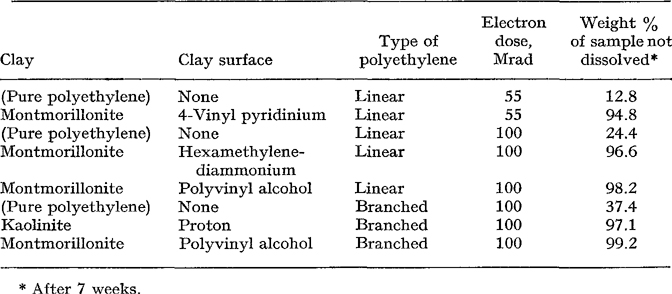Article contents
Organoclays Bonded to Polyethylene by Ionizing Radiation
Published online by Cambridge University Press: 01 January 2024
Abstract
Exploratory experiments on irradiation of mixtures of polyethylene and organo-montmorillonites with gamma rays indicated that the polyethylene became crosslinked to the organoclays. Subsequently, 264 samples of 1:1 clay-polyethylene compositions were irradiated with 2 MeV electrons and tested for tensile strength and weight fraction extractable in toluene at 110°C. From statistical analysis of the variables of clay lattice, clay surface, polyethylene type and radiation dose it is concluded that: (1) polyethylene can be bonded directly to the clay surface by ionizing radiation, and (2) at least one organoclay bearing a “polyethylenelike” chain, polyvinyl alcohol, is more effective than wholly inorganic clay for the purpose of radiatively linking polyethylene to clay surface. The data below show the markedly increased solvent resistance of polyethylene radiatively bonded to clay over that of equivalently irradiated pure polyethylene.

- Type
- General Session
- Information
- Clays and Clay Minerals (National Conference on Clays and Clay Minerals) , Volume 13 , February 1964 , pp. 317 - 330
- Copyright
- Copyright © The Clay Minerals Society 1964
Footnotes
Published by permission of the Union Oil Company of California.
References
- 3
- Cited by




